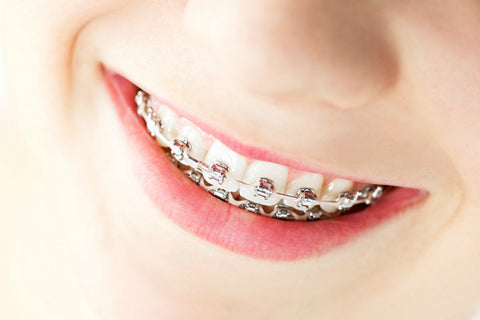What Are the Long Term Benefits of Introducing Orthodontics From an Early Age? 0
Although the common age to begin orthodontic treatment usually comes at the start of patients’ teenage years, introducing orthodontics from an early age could greatly reduce the need for more extensive and costly work further down the line. In fact a recent study from the American Journal of Orthodontics & Dentofacial Orthopedics, reports that many young children may benefit from orthodontic correction from as young as 6 years old.

The first permanent adult teeth will appear in children of around 6 years, just before their first baby teeth start to fall out. A lot of children will grow into their adult teeth without any trouble, however there are a few problems that can occur as the new teeth start to come through:
- Teeth can protrude out significantly, which can be exacerbated by thumb sucking from an early age
- A lack of space for the new teeth may lead to overcrowding and a misaligned bite
- There may also be too much space for the new teeth, called the ‘ugly duckling’ stage of development. Excess space usually closes with growth, though this is not necessarily always the case
- There may be a retention of the baby incisors, which can prevent the adult successors from coming through or lead them to develop over them
The study looked at the potentially damaging effects of protruding teeth in children from the ages of 6-10. It found that almost a third of children who were treated for severely protruding teeth were less likely to experience dental trauma, such as a chipped, broken, or knocked out permanent tooth.
As many children are highly active and enjoy sports or activities where there’s a higher risk of trauma, it’s advised that those in particular with severely protruding teeth, should visit their orthodontist early on. Not only will this reduce their risk of injury, it will also help to guide their teeth into a healthier position and could prevent the need for further orthodontic treatment when they’re older. In addition, in this early stage where children can be sensitive, having orthodontic treatment can help them to feel more confident in their smile as they grow.
Early Orthodontics – What Are the Options?

There are three main types of orthodontics suitable for children from a young age:
Preventative orthodontics
Preventative treatment can help avoid a malocclusion from developing due to spacing issues – tooth crowding or a misaligned bite. Here an orthodontist will be able to create enough space for the permanent teeth to come through normally. A common method is using a space maintainer.
Interceptive orthodontics
For children from the age of 6 years, visiting an orthodontist can catch problems early on before they develop into more severe dental issues. The risk of protruding teeth, especially through thumb sucking, can be corrected and reduce the need for later comprehensive orthodontic treatment. Permanent teeth can also be guided into the correct positions through tooth removal or size adjustment.
Comprehensive orthodontics
This is the typical treatment that teenagers receive to align the teeth and bite, however carrying out necessary comprehensive orthodontics from an early age, will again help to reduce the need for more complex and long-term treatment when they’re older. Children can have treatments including wearing realigning headgear or having fixed retainers to help close gaps and align their new adult teeth.
If you’d like to find out more about orthodontics for children, or to discuss your child’s orthodontic treatment, you can call the Northenden House team on 0161 9982622, or contact us here to book your initial consultation.
- Blue Horizons
- Tags: brace care children's dental care children's orthodontics Orthodontics
How Orthodontic Treatment Can Benefit Your Child 1
Children and teenagers can often be more easily affected by first impressions and especially conscious of their own. Having a great smile can make a lasting difference to their self-esteem, as well as their overall health. That’s why orthodontic treatment is such an important consideration for your child, so that they can feel confident and happy in their smile and the first impressions they’ll make. But at what age should you consider your child’s orthodontic treatment, what type of treatment will be best for them and what will it involve?
When to take your child to the orthodontist
There are different phases for orthodontic treatment; Phase One occurs when the child is around the age of eight or nine, known as early treatment. The second phase will take place for children from around the age of eleven, into the teenage years. Although currently, most children receive treatment when they’re around twelve years old, earlier orthodontic treatment can save a lot of time, money and inconvenience when it comes to Phase Two.
In fact, health bodies such as The American Association of Orthodontists, advise that children go for an orthodontic screening as early as seven years old. This way, an orthodontist can look for potential problems with jaw alignment and bite as they grow. An early examination can also help find extrusions which are likely to create spacing problems, if all the adult teeth haven’t come through. You’ll then be advised on the best solution for your child, or whether they’ll need future treatment at all.
Why your child might need orthodontic treatment
Overcrowded, crooked teeth, or a misaligned bite, though common in children and teenagers, can not only lead to poor oral health and wear or damage the teeth, they can also place pressure on the jaw and cause irregular growth – changing the facial structure. One of the factors that can contribute to orthodontic problems in children is thumb sucking, as it can cause the lower teeth to become set back or the upper teeth to protrude forward. Early intervention, therefore, is sometimes necessary to prevent enduring tooth and jaw problems. Orthodontics is most effective at an earlier age, before a child’s jaw stops developing, which is usually towards their adult years. Signs that your child may need orthodontic treatment include:
- If your child continues thumb sucking after 5 years of age
- Lisps or speech impediments
- Teeth are protruding, or don’t come together normally
- Crowding of the front teeth begins at around the age of seven or eight
- Your child has difficulty chewing or biting
- A shift in the jaw when they open or close their mouth
- They are breathing through their mouth
Phase One treatments in most cases begin once all of the adult teeth have started to come through and use methods and appliances to correct the position of the jaw and dental arches. If your child’s orthodontist sees that teeth coming through will likely cause crowding or other issues, they can use interceptive orthodontics to shift the size of the dental arch for better teeth positioning. This will decrease the likelihood of teeth having to be removed or additional orthodontic treatment as your child reaches teenage years, however Phase Two treatment is usually still needed. The future treatment will mostly be a lot shorter and less expensive though.

How an orthodontist can help improve your child’s teeth
Investing in orthodontic treatment for your child at an earlier stage, can prevent them needing it when they’re an adult, where it often takes longer and surgery may have to be involved. If you’re considering orthodontic treatment for your child, here are the problems it can help to correct:
- Orthodontics for your child can help to correct protruding upper front teeth, improving oral health, the appearance of the teeth, as well as reducing the risk of traumatic injury to the upper teeth.
- Crowded or asymmetrical teeth can be straightened and guided into a healthier position by creating space for teeth to grow. This will also help to correct damage to the teeth and shifting of the jaw over time.
- Incorrect bites can be corrected as orthodontics will guide the growth of the jaws, reducing the chances of abnormalities.
Most treatment will involve the use of braces, which are extremely effective and are much more comfortable and smaller than previously. You can check whether your child is permissible for free NHS orthodontic treatment, if they’re under the age of 18. At Northenden House Orthodontics we offer a wide choice of treatment options for children and can carry out treatment from NHS referrals. If you’d like to speak to us regarding treatment for your child, or to book your consultation, please contact the practice on 0161 998 2622 or email info@manchesterorthodontics.co.uk.
- Blue Horizons
- Tags: brace care children's dental care children's orthodontics Orthodontics traditional braces

